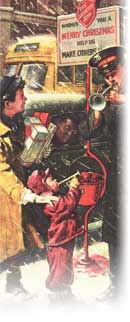Merry Christmas everyone!
From APOD:
Mars and Orion Over Monument Valley
Credit & Copyright: Wally Pacholka (Astropics.com)Welcome to The World At Night. Sharing the night sky seen around the world, this view from Monument Valley, USA includes a picturesque foreground of famous buttes. Buttes are composed of hard volcanic rock left behind after water eroded away the surrounding soft rock. The two buttes on the image left are known as the Mittens, while Merrick Butte is on the right. Recorded just last week, planet Mars is at the left of the skyscape, a glowing beacon of orange that is the brightest object in the frame. To the right of Mars lies the constellation of Orion. Betelgeuse is the reddish star near the center and the Belt of Orion and the Orion Nebula are farther right. Finally, the bright blue star Rigel appears above Merrick Butte in this stunning view of The World At Night.
Please click on the image for the full-sized view of this magnificent photo.



 Misión La PurÃsima Concepción De MarÃa SantÃsima (Mission of the Immaculate Conception of Most Holy Mary) was founded by Father Presidente Fermin de Lasuén on December 8, 1787 and was the 11th of 21 Franciscan Missions in California. During the Mission’s early years, several thousand Chumash Indians were baptized into the Catholic Church; over 100 large and small adobe buildings were built; a water system developed; crops and livestock raised and La Purisima grew and prospered.
Misión La PurÃsima Concepción De MarÃa SantÃsima (Mission of the Immaculate Conception of Most Holy Mary) was founded by Father Presidente Fermin de Lasuén on December 8, 1787 and was the 11th of 21 Franciscan Missions in California. During the Mission’s early years, several thousand Chumash Indians were baptized into the Catholic Church; over 100 large and small adobe buildings were built; a water system developed; crops and livestock raised and La Purisima grew and prospered.
 One of the first recorded instances of an annual spring festival is the festival of Osiris in Egypt; it commemorated the renewal of life brought about by the yearly flooding of the Nile. In Athens, during the 6th century B.C., a yearly celebration in honor of the god Dionysus was the first recorded instance of the use of a float. It was during the Roman Empire that carnivals reached an unparalleled peak of civil disorder and licentiousness. The major Roman carnivals were the Bacchanalia, the Saturnalia, and the Lupercalia.
One of the first recorded instances of an annual spring festival is the festival of Osiris in Egypt; it commemorated the renewal of life brought about by the yearly flooding of the Nile. In Athens, during the 6th century B.C., a yearly celebration in honor of the god Dionysus was the first recorded instance of the use of a float. It was during the Roman Empire that carnivals reached an unparalleled peak of civil disorder and licentiousness. The major Roman carnivals were the Bacchanalia, the Saturnalia, and the Lupercalia. St. Valentine’s Day falls on February 14, and is the traditional day on which lovers in certain cultures let each other know about their love, commonly by sending Valentine’s cards, which are often anonymous. The history of Valentine’s day can be traced back to a Catholic Church feast day, in honor of Saint Valentine. The day’s associations with romantic love arrived after the High Middle Ages, during which the concept of romantic love was formulated.
St. Valentine’s Day falls on February 14, and is the traditional day on which lovers in certain cultures let each other know about their love, commonly by sending Valentine’s cards, which are often anonymous. The history of Valentine’s day can be traced back to a Catholic Church feast day, in honor of Saint Valentine. The day’s associations with romantic love arrived after the High Middle Ages, during which the concept of romantic love was formulated.



 The Salvation Army Captain in San Francisco had resolved in December of 1891 to provide a free Christmas dinner to the area’s poor. But how would he pay for the food?
The Salvation Army Captain in San Francisco had resolved in December of 1891 to provide a free Christmas dinner to the area’s poor. But how would he pay for the food?